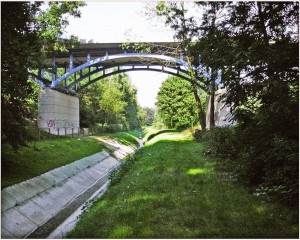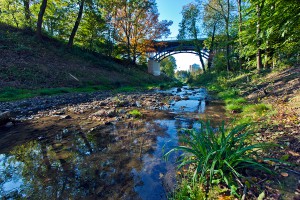Emscher mature site (Germany)

Borbecker Mühlenbach before renaturation © Emschergenossenschaft, Diethelm Wulfert
In the end of the 19th century, the Emscher region with a landscape of water meadows was transformed into an industrial conurbation and the untamed Emscher turned into a man-made system of open wastewater channels. Most of the creeks in the catchment as well as the Emscher River are heavily modified water bodies according to the Water Framework Directive. With the decline in the mining industry in the end of the 20th century, a second structural change began, also being reflected in a changing Emscher. In future, wastewater will be completely conveyed through closed conduits in a combined sewer system and the river and its tributaries will be re-converted into natural waterways.

Borbecker Mühlenbach after renaturation © Emschergenossenschaft, Diethelm Wulfert
This large-scale restoration, called the Emscher re-conversion, is a process lasting for three decades during which a total length of about 400 km of sewers and 290 combined sewer overflow (CSO) structures with a total volume of 485.000 m³ are to be built until 2017. In a second step, 350 km of water courses in an area of 865 km² will be ecologically revitalized until 2020 to complete the Emscher re-conversion project. Until now, 264 km of sewers and 91 CSOs with a volume of 485.000 m³ have been completed. From the 120 km of already restored water courses, DESSIN will investigate around 14 stream sections as mature sites.
A short movie about the Emscher area, its challenges and its ongoing restoration process:
Click here to get to the EGLV website. Contact for the mature site: Nadine Gerner, EG (Gerner.Nadine@eglv.de)